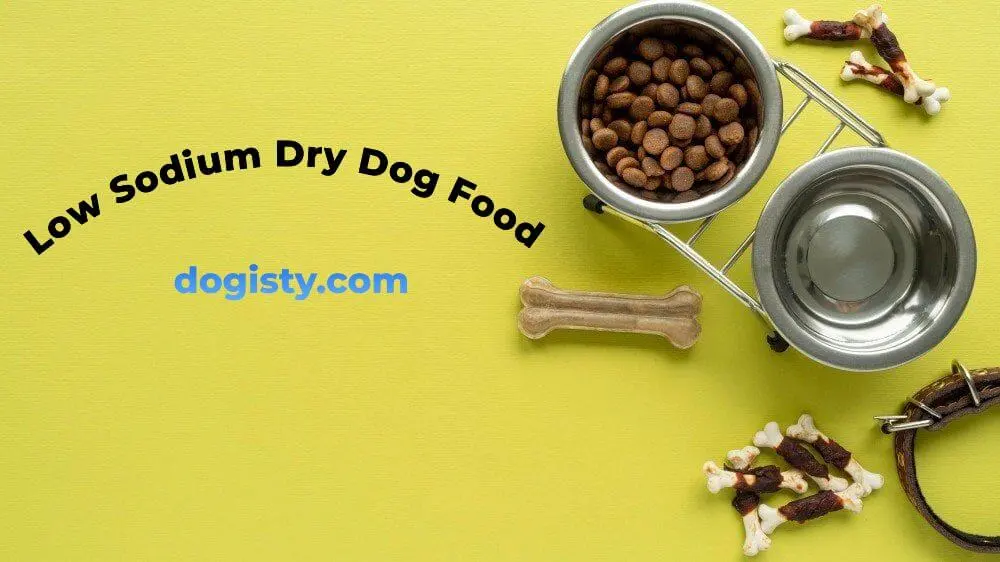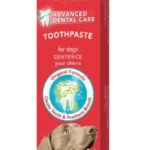According to research, most dogs consume more sodium than they should. Have you ever thought about how much sodium you feed your dog? Switching to a low sodium dry dog food can be a game-changer for your furry friend’s health.
Sodium is an important mineral for dogs, but like in humans, too much can lead to health issues, such as heart disease or high blood pressure. We’ll discuss sodium in dog food and recommend low sodium dry dog food options that could be the perfect fit for your pup.
Table of Contents
- What is The Role of Sodium in Your Dog’s Diet?
- How Do I Know If I Am Feeding My Dog the Right Amount of Sodium?
- When is Low Sodium Dry Dog Food Recommended?
- Conclusion
- FAQs
What is The Role of Sodium in Your Dog’s Diet?
Sodium contributes to maintaining proper cell function, fluid balance, and nerve transmission. It is a necessary mineral that supports overall health and well-being in canines when included in the right amounts.
The sodium content in dry dog food varies widely depending on the brand and product line. Generally, the sodium content can range from as low as 0.3% to more than 1.0% on a dry matter basis. However, the Association of American Feed Control Officials recommends at least 0.3% sodium levels in dog food.
Are Low Sodium Diets Harmful for Dogs?
In the right amount, sodium is not harmful. It poses health risks when in excess, particularly for dogs with certain medical conditions such as heart disease or kidney issues. On the other hand, a diet too low in sodium might not meet the basic physiological needs of a dog, especially for those who are healthy and active. It’s all about finding the right balance—enough sodium to support bodily functions without exposing your dog to the risks associated with high sodium intake.
How Do I Know If I Am Feeding My Dog the Right Amount of Sodium?
Determining the optimal sodium intake for your dog involves observation. In some cases, veterinary guidance, especially if your dog has preexisting health conditions.
Low sodium levels can manifest in symptoms such as lethargy, confusion, weakness, and even seizures in severe cases. Excess sodium intake can lead to symptoms such as excessive thirst and urination, indicative of the body’s attempt to balance the sodium levels. Therefore, if you are wondering why your senior dog drinks excess water, it could be from a high-sodium diet.
Over time, high sodium intake may result in more serious conditions like hypertension, heart disease, or kidney damage. If you notice any sudden changes in your dog’s behavior, drinking, or eating habits, consult a veterinarian to assess their dietary sodium levels and overall health.
When is Low Sodium Dry Dog Food Recommended?
Did your vet recommend you switch to a low sodium dry dog food? Low sodium dry dog food is often recommended for dogs with specific health conditions where reducing sodium intake is beneficial.
Heart failure and heart murmurs are classic examples. These conditions often require dietary adjustments to manage effectively. Switching their diet to include low sodium dog food for heart failure will improve their quality of life by easing the workload on their heart. Similarly, the best low sodium dog food for heart murmur cases can help manage symptoms and potentially slow disease progression.
Besides heart-related conditions, sodium restriction is also advantageous for dogs with kidney disease. Reduced sodium levels can help these dogs maintain normal blood pressure and decrease the chances of further kidney damage.
Like any other transition, switching to a low sodium diet might not be easy. Nevertheless, it provides a lot of health benefits for your dog. Carefully choose the right type of food that meets their nutritional requirements. Food should nurture your dog’s health and support their vitality, and going low on sodium could make a difference in their well-being.
How to Choose Low sodium Dry Dog Food
To begin with, how do you know if dog food is low in sodium? The key is in reading the labels. The sodium content is always listed on dog food labels, giving you the immediate info you need to make a healthy choice for your pet.
Dog food with 0.3% to 0.4% sodium content on a dry matter basis qualifies as low sodium. If you want to find the best low sodium dog food, consult your vet. They can offer personalized recommendations based on your dog’s specific health needs.
Several low sodium dry dog food brands have high ratings and positive reviews from pet owners. Brands like Hill’s Science Diet, Royal Canin, and Purina Pro Plan are frequently mentioned for their commitment to providing balanced nutrition that meets specific dietary needs, including low sodium options. If you are wondering where to start, these brands might be great.
4 Low Sodium Dog Food Options
There are different brands offering low sodium dog foods. Still, it doesn’t make it easy to pick one right for your canine friend. Here’s a quick list of several low sodium dry dog food options:
- Hill’s Science Diet Low Sodium Prescription Diet – is specially formulated to manage sodium intake for dogs with specific health conditions, ensuring they receive a balanced diet that supports their overall health.
- Royal Canin Veterinary Diet Cardiac Formula- offers targeted nutrition for dogs with heart conditions, aiming to improve cardiac function with low sodium levels.
- Purina Pro Plan Veterinary Diets Heart Health-aids the dietary management of dogs with heart disease through controlled sodium content to support heart health.
- Blue Buffalo Natural Veterinary Diet Kidney + Mobility Support- focuses on maintaining kidney health and mobility in dogs through a reduced sodium intake.
Understanding your dog’s health and dietary needs is key when shopping. Keep them happy, healthy, and active with the right low sodium dog food choice.
Can I Opt for Low Sodium Wet Dog Food Instead?
Yes. If your dog feeds better on wet food, there are low sodium wet dog food alternatives available. Like dry food, low sodium wet dog food should and can help meet your furry friend’s health requirements without sacrificing flavor or nutritional value.
Wet dog food is rich in moisture and beneficial for sodium management and hydration. The best low sodium wet dog food varieties offer the same advantages as dry food but in a form that many dogs find more appealing and easier to eat. Whether your dog faces heart, kidney, or general health issues, there’s likely a wet food option that fits the bill.
Can I Make Low Sodium Dog Food at Home?
You can, but it is not advisable. Homemade food will give you more control over your diet. It is reassuring that you will know what goes into your pet’s food. But, creating homemade low sodium dog food can be challenging and comes with certain risks. The primary concern is ensuring the food meets your dog’s nutritional needs. A diet lacking essential nutrients or not catering to your dog’s unique health requirements can do more harm than good.
Before venturing into the world of homemade low sodium dog food recipes, it’s essential to consult with a veterinarian. They can provide guidelines to ensure that any diet you prepare at home is nutritionally balanced and appropriate for your dog’s specific health conditions.
There may be a lot of low sodium dog food recipes available online, but the needs of each dog differ. What works for one dog may not necessarily be suitable for another, making professional advice invaluable.
Conclusion
Switching to a low sodium dry dog food will keep your dog healthy and support heart and kidney function. It could also extend their life expectancy. Choosing the right low sodium dry dog food will affect their health and quality of life. Consult your vet before deciding on a low sodium diet for your dog to ensure the food meets their nutritional needs without overlooking health conditions. Remember, every dog is unique, and what works for one may not work for another.
FAQs
Which dog foods are low in sodium?
Low sodium options often include specific veterinary prescription diets and some high-quality commercial brands focusing on heart or kidney health. Brands like Hill’s Science Diet and specific Purina Pro Plan formulas offer low sodium dog food options.
Is Royal Canin low in sodium?
It depends on the specific Royal Canin formula you’re considering. Check the label to understand the sodium content.
Does dry dog food have sodium?
Yes, all dog foods, including dry formulas, contain some sodium as it’s an essential nutrient for dogs, but the amount can vary widely between brands and formulas.
How can I lower my dog’s sodium levels?
Gradually transition your dog to a lower-sodium diet under veterinary guidance, and avoid giving your pet foods high in salt, such as human snacks and certain canned foods.
How do you know if a dog food is low in sodium?
Check the nutritional label for sodium content, and look for dog foods labeled “low sodium.” Consulting with your veterinarian can also help identify suitable low sodium options.
What dog food is high in sodium?
Foods not specifically designed for dogs with dietary restrictions, such as commercial non-prescription diets and many types of treats, tend to be higher in sodium.
Is low sodium bad for dogs?
Not necessarily. While dogs require some sodium for normal bodily functions, diets low in sodium can be beneficial for dogs with certain health conditions, such as heart or kidney disease.
Is sodium harmful to dogs?
In appropriate amounts, sodium is not harmful. It is, in fact, necessary for dogs. However, excessive sodium intake can lead to health issues, particularly for dogs with specific health concerns.
What is the salt rule for dog food?
There is no one-size-fits-all “salt rule” for dog food. The generally accepted guideline is that dog food should have a sodium content of at least 0.3% on a dry matter basis for dogs with heart disease. Always consult a veterinarian for advice specific to your dog’s needs.





